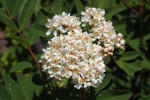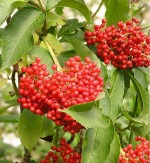 Sitka mountain ash is a deciduous shrub or small tree endemic to areas in the Pacific Northwest from Alaska and Yukon south to Montana and California, where it grows in open woods, rock outcropping, slogs, and bog margins. It is a member of the rose family , Rosaceae, that also includes cherries, hawthorns, and blackberries, and is not related to the true ash , Fraxinus. The pinnately compound leaves are four to eight inches long and have seven to eleven leaflets. They are blue-green until the fall when they turn yellow to purple color. In spring to early summer fifteen to sixty white flowers are produced in terminal clusters two to four inches across. They are followed by bright red berries with a waxy coating in the fall and are eaten by migrating birds. A good choice for a patio, lawn, specimen, or naturalistic planting in areas where night temperatures are cool. The generic name, Sorbus , is the Latin name for service tree. The specific epithet sitchensis refers to Stika, Alaska, where the plant is found.
Sitka mountain ash is a deciduous shrub or small tree endemic to areas in the Pacific Northwest from Alaska and Yukon south to Montana and California, where it grows in open woods, rock outcropping, slogs, and bog margins. It is a member of the rose family , Rosaceae, that also includes cherries, hawthorns, and blackberries, and is not related to the true ash , Fraxinus. The pinnately compound leaves are four to eight inches long and have seven to eleven leaflets. They are blue-green until the fall when they turn yellow to purple color. In spring to early summer fifteen to sixty white flowers are produced in terminal clusters two to four inches across. They are followed by bright red berries with a waxy coating in the fall and are eaten by migrating birds. A good choice for a patio, lawn, specimen, or naturalistic planting in areas where night temperatures are cool. The generic name, Sorbus , is the Latin name for service tree. The specific epithet sitchensis refers to Stika, Alaska, where the plant is found.
 Type: Shrub, small tree
Type: Shrub, small tree
Outstanding Features: Flowers, fall color, berries
Form: Erect, rounded crown
Growth Rate: Slow
Bloom: Fifteen to sixty white flowers in terminal clusters two to four inches across from spring to early summer
Size: 1’ W0-20’ H x 6-10
Light: Full sun to part shade
Soil: Average, moderately moist
Hardiness: Zones 3-6
Care: Low maintenance
Pests and Diseases: None of significance
Propagation: Seed
Photos from Hansen’s Northwest Native Plant Database